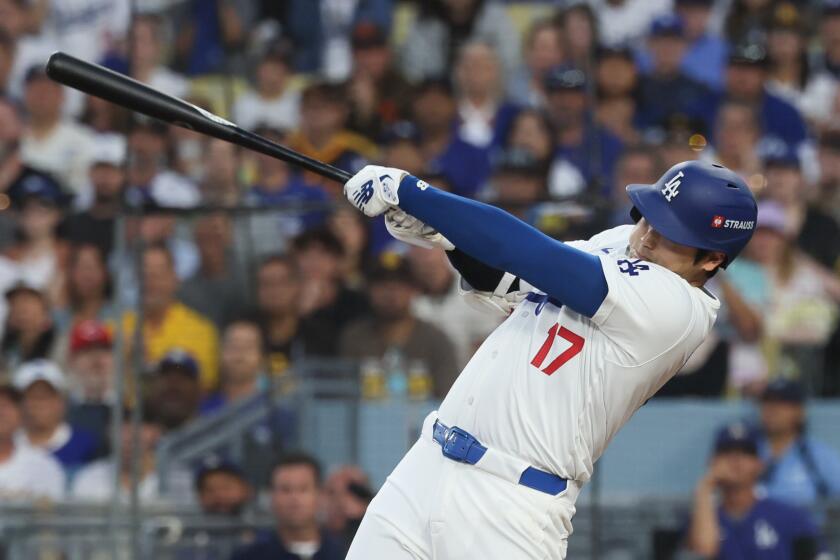Numbers Whiz a Winner at Math Olympiad
- Share via
David Grabiner is one of the lucky few in the United States who can say he has competed in an international Olympiad this year and won a gold medal.
But unlike athletes who give their last bit of physical strength for Olympic gold, Grabiner, 18, who graduated from Claremont High School this year, displayed neither strength nor speed.
Instead, he used his wizardry with figures to help the United States finish in a first-place tie with the Soviet Union at the 27th International Mathematics Olympiad in Warsaw on July 9 and 10. He competed against 209 teen-agers from 37 countries.
Grabiner and five other young Americans were chosen to represent the United States from about 300,000 high school students who took three qualifying exams.
Met Other Math Experts
“The best thing . . . was the opportunity to meet all the people,” said Grabiner, who has since returned home.
As a result, he said, “when I go to an international math gathering 20 years from now, I am going to either give a presentation for people I know or see people I know give presentations.”
For Grabiner, forming bonds with other young mathematicians is important to his goal of becoming a mathematics professor.
“He has a good feeling for the social aspect of being a mathematician in that it’s all one community working together, and he is very quickly becoming a part of it,” said his father, Sandy, a mathematics professor at Pomona College.
Sharpening Skills
According to Sandy Grabiner, the Warsaw Olympiad helped the students improve their skills. Most contestants went through training sessions, often for as long as a month.
The six problems they were given to solve at the Olympiad required creativity rather than just following formulas.
“These are not just problems you can plug into a computer and get an answer,” said Judith Grabiner, David’s mother and a science historian who teaches at Pitzer College.
The problems usually were solved by the use of different mathematical reasoning, and often there was more than one correct solution.
Grabiner and the other participants were given three questions each day and asked to answer them in 4 1/2 hours.
Three Perfect Scores
Each student received the same questions, which were devised by a panel composed of one representative from each country that participated in the Olympiad.
The students could receive up to 7 points for each of the questions, for a maximum score of 42. Gold medals were given to students who scored 34 points or higher.
Three students received perfect scores of 42, including a young mathematician from Hungary. Leading the United States was Joseph Keane, 17, of Pittsburgh, who received 41 points and was the only participant in the Olympiad given a special prize for a “particularly original and elegant solution” to one of the questions.
Grabiner racked up 37 points, followed by Jeremy Kahn, 16, of New York City, who won the third gold medal for the United States.
Tied With Soviet Union
In team totals, the United States tied for first with the Soviet Union, whose representatives also won three gold medals. As is the custom in many foreign competitions, the “gold medals” actually were vases.
Grabiner said that he treasures the time he can spend with young math wizards from around the globe.
“We had a lot of time to spend with each other, and let it be on record that I beat the Romanians at two rubbers of bridge,” he said.
Grabiner attempted to speak to members of the team from Vietnam and was disappointed to find that none of them spoke English or French, which he also speaks fluently.
Foreign Friends
But there was consolation in knowing that he could always communicate with his good friends from Kuwait and Morocco, whom he met at the Olympiad in Finland last year.
Grabiner won a silver medal in Finland, where the United States took second place overall. In the 1984 competition, he also won a silver medal.
“I guess I could speak to three-fourths of the people (in Warsaw) because most of them speak either English or French,” said Grabiner.
Sandy Grabiner said his son “showed considerable intellectual ability before the first or second grade. . . . He could read minimally before he was 2.”
By the time young Grabiner was in the fourth grade, the teachers at Sycamore Elementary School in Claremont had taught him all the mathematics they knew. Arrangements were made with his father so that he could chose books for his son and assign problems for him to solve.
Credit to Teachers
“When a kid is unusual academically, when he is bright or unconventional, sometimes he is sat on by the students or by the teachers,” said Judith Grabiner. “It is a credit to the teacher that she wasn’t threatened by the fact that he could do something that the teacher couldn’t.”
Grabiner continually scored so many points in local competitions that the school’s math team swept the awards. This year he also won first place in a national chemistry competition sponsored by the Junior Engineering Technical Society.
Two years ago Grabiner began coaching the school’s math team.
“Most of the math club sessions are tutoring sessions, and he is always the one who has the answers to all the problems,” said Ronald Meyer, assistant principal at the high school and sponsor of the math team. “He is a very caring person and works to help others.
Grabiner was so advanced in math that he began taking classes at Pomona College two years ago.
He said that it was not too unusual for someone his age to take college courses and be at the same level with students several years older.
“I didn’t get to know them as well as they know each other because I was only there for class time . . . but I met people and discussed different things with them outside of class,” he said.
Will Attend Princeton
And as Grabiner prepares to go to Princeton University in the fall, he is once again ahead of his peers, since he already has taken about two years of university mathematics. By his junior year, he will be taking graduate courses.
More to Read
Go beyond the scoreboard
Get the latest on L.A.'s teams in the daily Sports Report newsletter.
You may occasionally receive promotional content from the Los Angeles Times.





